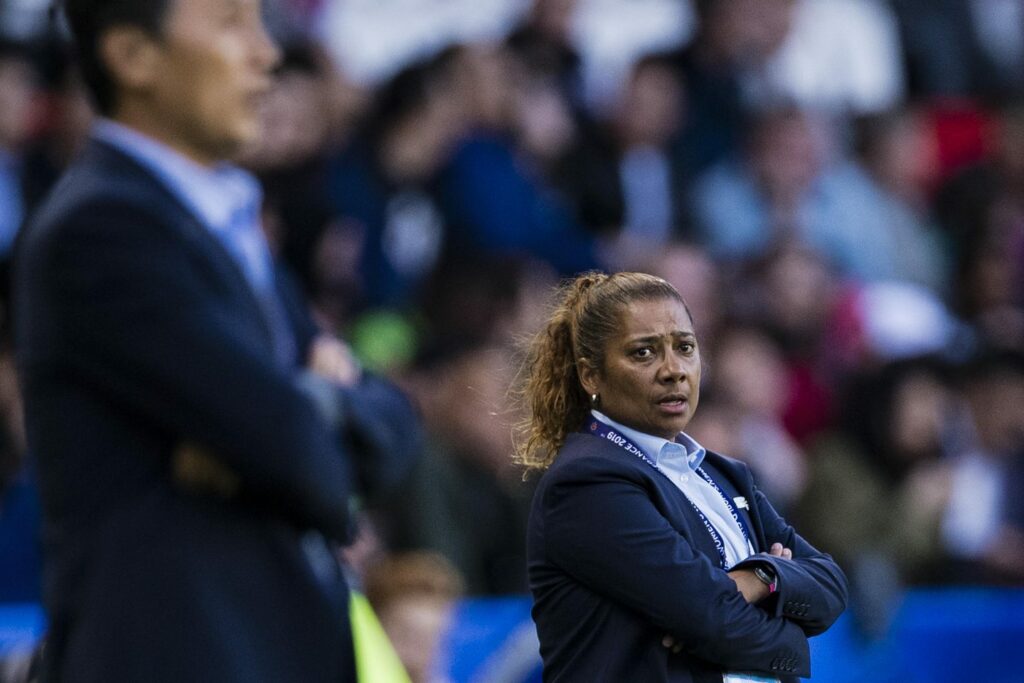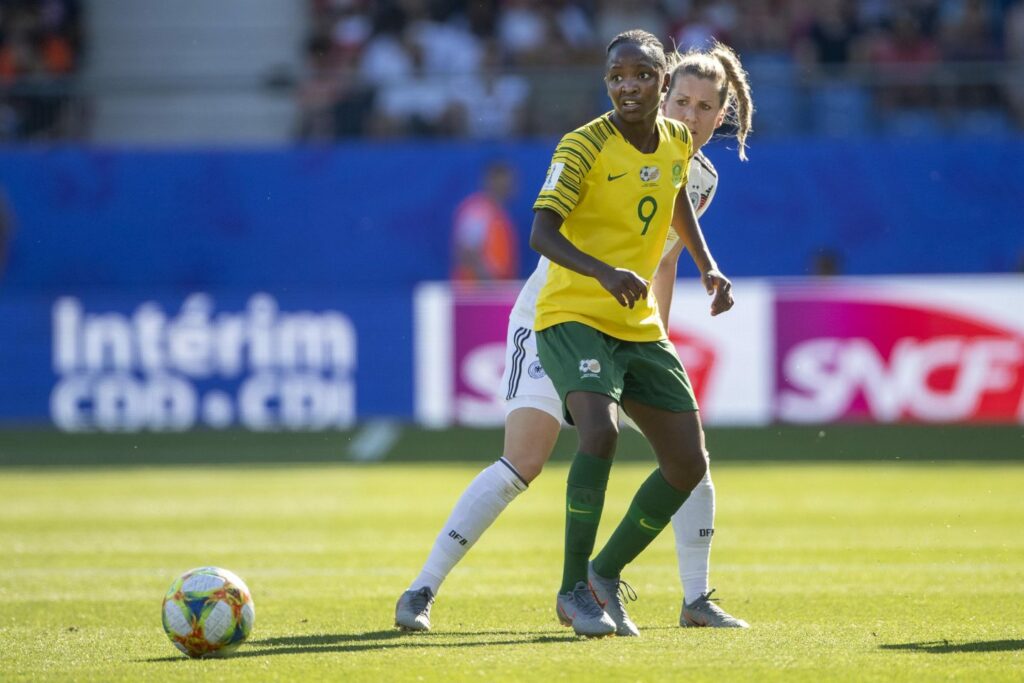Dashed: United States forward Carli Lloyd (right) battles with South Africa defender Bambanani Mbane to score one of the three goals in the 3-0 US victory. (Robin Alam/Icon Sportswire/Getty Images)
Noko Matlou’s prophetic words towards the end of 2019 have materialised in a big way. “After the game against Japan [in November last year], I told the players most of us will be signed by teams abroad and it immediately started happening this year,” says the Banyana Banyana stalwart who is the first South African to be named CAF’s Footballer of the Year.
There has been a sharp rise in South African women footballers earning professional contracts overseas, especially in the United States, Europe and China. These are leading forces in women’s football in the world. The international exposure Banyana got from appearing in the 2019 Fifa Women’s World Cup in France made it easier to “sell” players abroad. It’s also easier for Banyana Banyana to get friendlies with the world’s powerhouses now.
Matlou had previously said that the World Cup was the only missing piece in her puzzle. Banyana’s, too. She got that piece and more when she represented South Africa in France in the global showpiece and Spanish side Eibar signed the 35-year-old in the twilight of her career. Even though age wasn’t on her side, she hadn’t given up on her dream of playing abroad.
“The fact that our players are playing abroad will have a huge impact on the national team,” said Matlou. “Going to play overseas, you will improve on a lot of things because you will be playing week in and week out. Most of the core of Banyana Banyana players are playing abroad. This is also an opportunity for players playing locally to rise so they can get the chance.”
Matlou joined Amanda Mthandi in Spain. Mthandi was studying at the University of Johannesburg (UJ) when she was signed by Spanish side CD Badajoz Femenino in July.
“We learn different styles of play and gain knowledge with different coaches. It also helps when we get back to camp with the national team,” Mthandi said.
The success of players like Andisiwe Mngcoyi abroad, and then the new crop – the likes of Thembi Kgatlana and Linda Motlhalo – have also gone a long way in ensuring that overseas teams have trust in South Africans.
“Players who go abroad are ambassadors for South Africa,” said Banyana coach Desiree Ellis. “They create opportunities for others because we only had Bambanani Mbane in Belarus and now we have Lebogang Ramalepe and others playing there. They went abroad without playing in the World Cup. They opened up the doors for this new crop of players in the national team.”
Ending the Awcon struggle
While the number of overseas-based players is increasing, the one challenge that Banyana have struggled to shake is continental dominance. The best they have done in the Africa Women’s Cup of Nations (Awcon) is losing in the final. They have done so five times.
In 2016, when Banyana finished a disappointing fourth place and missed out on being one of the continent’s three representatives in the World Cup, Ellis identified what separated the team from the likes of Nigeria and Cameroon.
“You could see the Nigerian team’s level of play was higher because most of their players are abroad and they train day in and day out. I pray our girls can bring that experience to the national team and take us to a different level.”
 Banyana Banyana head coach Desiree Ellis in Paris, France, during the World Cup. (Photograph by Marcio Machado/ Getty Images)
Banyana Banyana head coach Desiree Ellis in Paris, France, during the World Cup. (Photograph by Marcio Machado/ Getty Images)
But Banyana would come close to conquering the continent in 2018, losing to Nigeria in the final after beating them in the group stage. Their second-place finish was enough to book them a ticket to France to play in their first ever World Cup.
“We showed how we could play and proved we could fight and compete,” Ellis says of their showing at the tournament. “It really showed the qualities of players. Immediately after the World Cup, Refiloe Jane was one of the first people to go abroad, followed by a number of players. The whole team has been to two Olympics, but we could have not asked for a better competition than the World Cup.
“The dream of going to the World Cup wasn’t just the dream of the current crop. Every player wanted to see us there. I had a dream of going to the World Cup and being part of the team now … my dream was realised. And I think players that have come before, seeing Banyana Banyana at the World Cup, their dreams were also realised.
“We showed the world what South African football is about, but we have to stay consistent in our performance. It’s a work in progress.”
Banyana are in a rebuilding stage after failing to qualify for next year’s Olympics, which is why Ellis injected fresh blood into the team. Most of the players she took to the Cosafa Women’s Championship in Port Elizabeth are still finding their feet in international football with the senior women’s national team. Despite that, this group reached the final of the Cosafa Women’s Championship. They will take on Botswana at Wolfson Stadium on Saturday 14 November.
 Amanda Mthandi in action against Germany at the Stade de la Mosson in Montpellier, France, during the Fifa Women’s World Cup. (Photograph by Tim Clayton/ Corbis via Getty Images)
Amanda Mthandi in action against Germany at the Stade de la Mosson in Montpellier, France, during the Fifa Women’s World Cup. (Photograph by Tim Clayton/ Corbis via Getty Images)
While Banyana players are progressing abroad, women’s football in the country is stuttering. The Sasol League and the Safa National Women’s League are amateur structures with a lot of limitations.
“It is unfortunate we do not have a professional league. Players opt to move abroad because we don’t have a professional league,” says Mthandi. “If we had sponsors, then most players would not leave the country. However, it is also a benefit for the national team.
“For example, the PSL [Premier Soccer League] players get to play week in and week out. But with us, we have to wait for the national league and the [Sasol League] national champions league. The national championships this year will not be happening [owing to Covid-19 restrictions], so the players based locally do not get to play competitive football. I feel we get taken seriously [only] when we qualify for major tournaments. We should also have tournaments such as the MTN8 or the Telkom Knockout competition because it equates to more playing time. My wish is for the team to get more sponsors.”
Matlou echoes Mthandi’s sentiments. “Women’s football is growing in South Africa and it is time we have a professional league and not a semi-professional league,” she says.
Matlou also says every PSL team should have a women’s team, because “it would be the most practical solution [in ensuring that women’s] teams get to play regularly”.
This article was first published by New Frame.